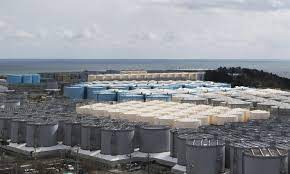Global scientists leading some of the world’s best marine laboratories have called for a stop to Japan’s plans release of over 1.3 million tons of radioactively contaminated water from the Fukushima-Daiichi Nuclear Power Plant disaster into the Pacific Ocean next year.
The U.S National Association of Marine Laboratories (NAML), an organisation of more than 100 member laboratories, expressed their opposition in a position paper published this month. They say there is a lack of adequate and accurate scientific data supporting Japan’s assertion of safety, and an abundance of data demonstrating serious concerns about releasing radioactively contaminated water.
They call on the Government of Japan and International Atomic Energy Agency (IAEA) scientists to more fully and adequately consider the options recommended by the Pacific Islands Forum’s Expert Panel.
The Panel was appointed by the Forum last year to help Pacific Forum members in their discussions with Japan and TEPCO officials. In a release from COP27, the Secretary General of the Pacific Islands Forum hinted at a change in the Forum’s earlier position of checking the water was safe with discharge, to looking at options other than discharge.
The PIFS Secretary General Henry Puna has met with Dr Ken Buesseler in the margins of COP 27 in Sharma El Sheik Egypt, to discuss the impending discharge of contaminated nuclear wastewater into the Pacific Ocean from Japan’s Fukushima Nuclear Power Plant. Dr Buesseler is the Senior Scientist at the Woods Hole Oceanographic Institution.
A marine radiochemist who studies the fate and distribution of radioactive elements in the ocean, his lab has been active in response to radioactivity released from disasters such as the impact of radioactivity released from the Fuksuhima Dai-ichi nuclear power plant, and from earlier sources such as Chernobyl or atomic weapons testing at the Marshall Islands. There has been no report of Japan-PIF meetings on Fukushima waste water plans since September 2022.
“We believe public policy decisions, regulations, and actions must keep pace with and make use of relevant advancements in our scientific understanding of the environment and human health. In this case, we believe policy makers have not fully availed themselves of the available science and should do so before making any final decisions on releasing this contaminated water into the Pacific,” the paper states.
“NAML members are unified in our concern about use of the oceans as a dumping ground for radioactively contaminated water and other pollutants because such actions can negatively affect the long-term health and sustainability of our planet.
“We urge the Government of Japan to stop pursuing their planned and precedent-setting release of the radioactively contaminated water into the Pacific Ocean and to work with the broader scientific community to pursue other approaches that protect ocean life; human health; and those communities who depend on ecologically, economically, and culturally valuable marine resources,” states the paper.
The Pacific Ocean is the largest continuous body of water on our planet, containing the greatest biomass of organisms of ecological, economic, and cultural value, including 70 percent of the world’s fisheries. The health of all the world’s ocean ecosystems is in documented decline due to a variety of stressors, including climate change, over-exploitation of resources, and pollution.
The proposed release of this contaminated water is a transboundary and transgenerational issue of concern for the health of marine ecosystems and those whose lives and livelihoods depend on them, states the paper.
“We are concerned about the absence of critical data on the radionuclide content of each tank, the Advanced Liquid Processing System, which is used to remove radionuclides, and the assumption that upon the release of the contaminated wastewater, “dilution is the solution to pollution.”
The underlying rationale of dilution ignores the reality of biological processes of organic binding, bioaccumulation, and bioconcentration, as well as accumulation in local seafloor sediments. Many of the radionuclides contained in the accumulated waste cooling water have half-lives ranging from decades to centuries, and their deleterious effects range from DNA damage and cellular stress to elevated cancer risks in people who eat affected marine organisms, such as clams, oysters, crabs, lobster, shrimp, and fish. Additionally, the effectiveness of the Advanced Liquid Processing System in almost completely removing the over 60 different radionuclides present in the affected wastewater—some of which have an affinity to target specific tissues, glands, organs, and metabolic pathways in living organisms, including people—remains a serious concern due to the absence of critical data.”
The supporting data provided by the Tokyo Electric Power Company and the Japanese Government are insufficient and, in some cases, incorrect, with flaws in sampling protocols, statistical design, sample analyses, and assumptions, which in turn lead to flaws in the conclusion of safety and prevent a more thorough evaluation of better alternative approaches to disposal. A full range of approaches to addressing the problem of safely containing, storing, and disposing of the radioactive waste have not been adequately explored, and alternatives to ocean dumping should be examined in greater detail and with extensive scientific rigor.
SOURCE: PACNEWS














